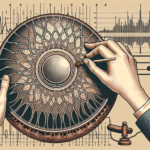Handpan music has captivated audiences around the world. Its unique sound and the ethereal quality of its melodic and percussive tones make it a fascinating instrument to explore. This article delves into the rhythmic patterns in handpan music, showcasing its versatility and the nuanced percussive melodies it can produce.
The Origin and Structure of the Handpan
The handpan, often referred to as a hang drum, originated from Switzerland in the early 2000s. Developed by Felix Rohner and Sabina Schärer of PANArt, the handpan has a distinctive, UFO-like shape. Crafted typically from two half-shells of nitrided steel, it has a central note (ding) surrounded by a circle of tone fields. Each of these fields is carefully hammered and tuned to produce a specific note when struck.
Understanding Rhythmic Patterns in Handpan Music
Basic Rhythmic Elements
At its core, handpan music combines rhythm and melody in ways that are both simple and profoundly complex. The instrument’s design allows for rich harmonic overtones, which means that each strike can carry both a rhythmic and melodic intention.
Patterns and Techniques
1. **Single Strike Patterns**: The simplest form of handpan playing involves striking one note repeatedly. This creates a rhythmic emphasis on that particular tone, allowing the musician to build a steady, meditative beat that can serve as the foundation for more complex compositions.
2. **Alternating Hands**: This technique involves striking notes alternately with the left and right hands. By doing this, musicians can create faster, intricate patterns that still maintain clarity and harmony.
3. **Rolls and Flams**: Rolls involve rapidly striking one or more notes to produce a continuous sound. Flams, borrowed from traditional drumming, involve striking a note almost simultaneously with each hand, creating a richer, more resonant sound.
4. **Ghost Notes**: These are softer notes played in between the main beats. They add texture and depth to the composition without overwhelming the primary melody.
Advanced Rhythmic Techniques
1. **Polyrhythms**: Polyrhythms involve playing multiple, differing rhythms simultaneously. For example, a musician might keep a steady 4/4 time signature with one hand while the other hand plays in 3/4 or 6/8. This creates an intricate web of sound that can be both challenging and rewarding to listeners and performers alike.
2. **Syncopation**: This technique shifts the emphasis from the main beats to the offbeats, creating a sense of surprise and variation. Syncopation can transform a simple beat into a more complex and engaging rhythmic pattern.
The Role of Melody in Handpan Music
Melody in handpan music isn’t separate from rhythm; instead, the two elements are deeply intertwined. The handpan’s tone fields are arranged in such a way that they naturally lead the player to explore different melodic phrases.
Compositional Techniques
1. **Motifs and Themes**: Repeating motifs or themes is a common technique in handpan music. Musicians can take a simple theme and manipulate it by changing the tempo, dynamics, or harmony. This not only aids in building a musical narrative but also allows the performer to explore different emotional landscapes.
2. **Improvisation**: Improvisation is a key element of handpan music. Given the instrument’s intuitive layout, musicians often find themselves creating spontaneous compositions, letting their hands guide them across the tone fields. This results in a fresh and unique listening experience every time.
Influences and Inspirations
Handpan music draws on influences from various musical traditions. Elements of Indian classical music, African drumming, and Western classical music can often be heard in handpan performances. This diversity of influences allows handpan music to appeal to a wide audience and to be an instrument of global resonance.
World Music Traditions
1. **Indian Classical Music**: The rhythmic cycles (taalas) and melodic structures (ragas) of Indian classical music offer endless inspiration for handpan players. The instrument’s ability to articulate complex rhythms makes it a natural fit for exploring these traditions.
2. **African Drumming**: The polyrhythmic nature of African drumming can be beautifully emulated on the handpan. The layers of rhythm and the call-and-response patterns typical of African music find a new expression in the melodic and percussive capabilities of the handpan.
3. **Western Classical Music**: The structured yet emotive qualities of Western classical music also influence handpan compositions. The instrument’s rich harmonic overtones provide a new avenue for exploring the intricacies of classical melodies and harmonies.
Modern Innovations and Future Directions
The handpan is a relatively young instrument, and as such, it is still evolving. Modern makers are experimenting with different materials and tunings to expand the instrument’s capabilities. Advances in technology are also paving the way for new forms of handpan-related compositions and performances. For example, integrating electronic effects and looping techniques allows musicians to create multi-layered soundscapes that push the boundaries of traditional handpan music.
Electronic Innovations
1. **Loop Stations**: Using loop stations, handpan players can record and layer multiple phrases in real-time. This technique is especially popular in live performances, where it enables the creation of complex, evolving compositions.
2. **Effects Pedals**: Adding reverb, delay, and other effects can significantly alter the sound of the handpan, making it even more versatile and expressive. Effects can be used to enhance the instrument’s natural resonance or to introduce entirely new textures.
The Future of Handpan Music
The future of handpan music is bright and full of potential. As more musicians and audiences discover the unique qualities of the instrument, its repertoire will continue to grow. Collaborations with artists from different musical genres and the incorporation of new technologies will likely result in innovative performances and recordings, ensuring that the handpan remains a dynamic and evolving instrument.
Conclusion
Exploring rhythmic patterns in handpan music reveals the intricate balance between melody and percussion that this unique instrument offers. From its simple origins to its complex compositions and potential future innovations, the handpan stands as a testament to the beauty of musical evolution. Whether used for meditative soundscapes or rich, polyrhythmic tapestries, the handpan continues to inspire musicians and audiences alike with its versatile and enchanting sound.
FAQs
1. What is a handpan?
A handpan is a percussion instrument made from two half-shells of nitrided steel, tuned to produce specific notes when struck. It combines both rhythmic and melodic elements, offering a unique and versatile sound.
2. How is handpan music different from traditional drumming?
While traditional drumming focuses primarily on rhythm, the handpan allows for the integration of melody and harmony. Each strike produces not just a percussive sound but also a note, enabling complex musical compositions.
3. Can anyone learn to play the handpan?
Yes, the handpan is relatively easy to pick up, especially for beginners. Its intuitive layout encourages exploration and improvisation. However, mastering advanced techniques and rhythmic patterns requires practice and dedication.
4. Where can I buy a handpan?
Handpans are available from specialized manufacturers and instrument makers. Due to the instrument’s handcrafted nature, they can be relatively expensive, and wait times for custom orders can be long. It’s important to buy from reputable sources to ensure quality.
5. What styles of music can be played on a handpan?
The handpan is incredibly versatile and can be used in a variety of musical styles, from meditative and ambient music to jazz, classical, and world music traditions. Its ability to blend rhythm and melody makes it adaptable to many genres.





